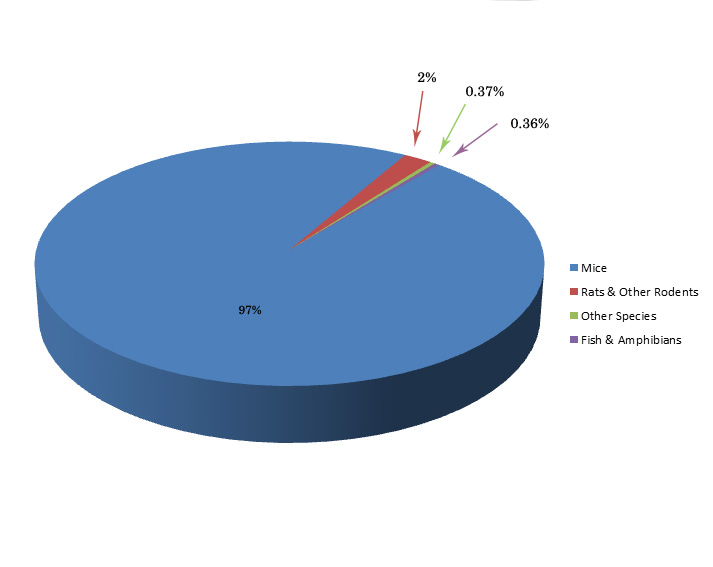Our Animals
UC San Diego is a world leader in the development and use of non-vertebrate mechanisms minimizing the use of vertebrate species. By far, the majority of scientific investigations involve cells in culture, fruit flies, roundworms, and other invertebrate animals. However, some questions can currently only be evaluated within the complexity of vertebrate animal species, and federal law requires vertebrate animal testing prior to conducting human clinical trials.
More than 98 percent of the vertebrate animals used in research at UC San Diego are laboratory mice, fish, rats and other small rodents, mainly because of their size, natural short life span and their similarities to biological function and disease processes in humans. Other vertebrate species also share their own biological similarities with humans and are used in research; however they represent less than 0.1 percent of all research animals used.
Animal well-being is the highest priority in the development and conduct of each project/experiment.
Resident Animal Species

*Animal numbers based on 2021-2022 fiscal year.
Animals involved in teaching, training or research are specifically bred for research, and are purchased only from licensed laboratory animal vendors.
Whenever possible, alternative methods to replace animals are used. In some cases questions can be answered using methods, such as computer modeling, cell culture or bacterial systems.
However, none of these techniques are capable of imitating the complex nature of how a disease or a drug affects the entire body. While technology is improving at a rapid pace, there are still no suitable alternatives to animals for many areas of medical inquiry.
Investigators must refine their studies by optimizing procedures to maximize the comfort and welfare of animals. They are also required to reduce the number of animals to the minimum needed to obtain accurate and informative results.
Animal Care
Animals are housed in facilities that provide for their safety and welfare. These facilities meet or exceed all regulatory requirements for the humane care and use of animals in research, teaching and training. Facilities are well-ventilated and continuously monitored for such environmental factors as temperature, light and humidity.
Husbandry, environmental enrichment and veterinary care - including fresh, high-grade animal foods, water and bedding appropriate for each species - are provided to all animals as required 7 days a week, 24 hours a day.
Animal care and research personnel must complete mandatory training to assure knowledge and proficiency in the humane care and use of animals in teaching, research and training.
At the end of its project/experiment, the animal subject involved will:
- Be humanely euthanized (tissue collected for analysis as necessary for experimental data)
- Die naturally or as an experimental consequence (tissues often collected for analysis)
- Be adopted out (where appropriate) to a pre-screened home (animal must pass physical exam and be vaccinated and spayed/neutered as appropriate for species)
- Rarely, be enrolled in another project
Ultimately, the experimental data are the animals' life legacy.